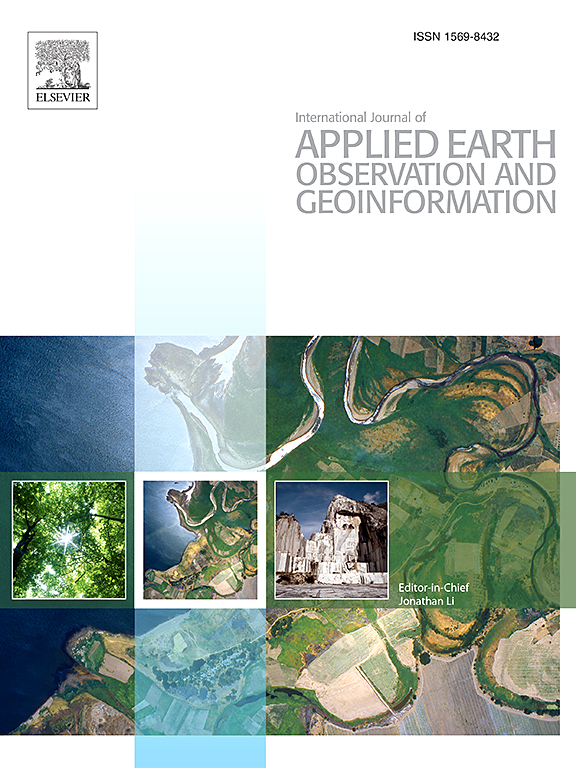遥感底栖生物栖息地空间明确不确定性量化的基于云的框架
IF 7.6
Q1 REMOTE SENSING
International journal of applied earth observation and geoinformation : ITC journal
Pub Date : 2025-06-13
DOI:10.1016/j.jag.2025.104670
引用次数: 0
摘要
基于云的遥感框架的重大进步使研究人员能够开发大规模的分析,以更好地理解、监测和决策敏感和有价值的沿海生态系统,如海草草甸。然而,已经确定了与机器学习(ML)产品的空间显式准确性相关的信息差距。本研究的目的是估计四种底栖生物栖息地随机森林分类的每像素不确定性,并利用它通过自举和生成集成模型的训练数据选择来重新训练模型。空间显式不确定性的计算是基于香农熵方程和根据ML模型成功预测的概率值。本研究的遥感数据分别来源于欧盟哥白尼哨兵-2 (Copernicus Sentinel-2)双星系统和Planet的立方体卫星星座,并通过谷歌Earth Engine云平台进行处理和分析。巴哈马群岛的全国范围和印度尼西亚瓦卡托比群岛的区域范围构成了我们的研究地点。我们的研究结果表明,所提出的不确定性工作流在优化分类方面的潜力,以及通过我们提供的空间显式精度度量来帮助政策制定者的不确定性地图的有用性。更准确地说,在巴哈马,与标准监督分类相比,海草使用者和生产者准确度的百分位数差异分别在1.16 - 4.77%和4.36 - 8.54%的范围内得到改善。综上所述,空间显式不确定性信息可以而且应该被用作适合ML分类优化的独特和重要的地理空间信息,并作为更好的决策和野外考察规划以及了解底栖生态系统的工具。本文章由计算机程序翻译,如有差异,请以英文原文为准。
A cloud-based framework for the quantification of the spatially-explicit uncertainty of remotely sensed benthic habitats
The significant advances of cloud-based remote sensing frameworks have allowed researchers to develop large-scale analytics for better understanding, monitoring of, and decision-making around sensitive and valuable coastal ecosystems like seagrass meadows. However, an information gap related with the spatially-explicit accuracy of Machine Learning (ML) products has been identified. The goal of this study is to estimate the per pixel uncertainty of a Random Forest classification of four benthic habitats and exploit it to retrain the model through training data selection by bootstrapping and producing an ensemble model. The calculation of the spatially-explicit uncertainty is based on the Shannon Entropy equation and the probability values of a successful prediction according to the ML model. The remote sensing data for this study are sourced from the European Union Copernicus Sentinel-2 twin satellite system and Planet’s cubesat satellite constellation respectively, and have been processed and analyzed through the Google Earth Engine cloud-based platform. The national extent of The Bahamas and the regional extent of the Wakatobi archipelago in Indonesia comprise our study sites. Our results indicate the potential of the presented uncertainty workflow for optimizing the classification and the usefulness of the produced uncertainty map to aid policy-makers through our provided spatially-explicit accuracy metrics. More precisely in the case of the Bahamas, the percentile differences for seagrass user and producer accuracies are improved in the ranges of 1.16–4.77 % and 4.36–8.54 %, respectively, in comparison with a standard supervised classification. In conclusion, spatially-explicit uncertainty information can and should be used as unique and vital geospatial information suitable for ML classification optimization and as a tool for better decision-making and field expedition planning, and understanding of benthic ecosystems.
求助全文
通过发布文献求助,成功后即可免费获取论文全文。
去求助
来源期刊

International journal of applied earth observation and geoinformation : ITC journal
Global and Planetary Change, Management, Monitoring, Policy and Law, Earth-Surface Processes, Computers in Earth Sciences
CiteScore
12.00
自引率
0.00%
发文量
0
审稿时长
77 days
期刊介绍:
The International Journal of Applied Earth Observation and Geoinformation publishes original papers that utilize earth observation data for natural resource and environmental inventory and management. These data primarily originate from remote sensing platforms, including satellites and aircraft, supplemented by surface and subsurface measurements. Addressing natural resources such as forests, agricultural land, soils, and water, as well as environmental concerns like biodiversity, land degradation, and hazards, the journal explores conceptual and data-driven approaches. It covers geoinformation themes like capturing, databasing, visualization, interpretation, data quality, and spatial uncertainty.
 求助内容:
求助内容: 应助结果提醒方式:
应助结果提醒方式:


